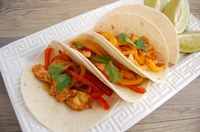Prairie Fare: 10 Tips to Help Pare Off Some Pounds
(Click an image below to view a high-resolution image that can be downloaded)
By Julie Garden-Robinson, Food and Nutrition Specialist
NDSU Extension Service
“I might eat the napkin, too,” my husband said as he squeezed a packet of hot sauce on a breakfast burrito.
He usually doesn’t have any hot sauce, but he was squeezing on as many calories as he could. I had ordered one burrito for each of us, and he usually has two.
“I only had one bowl of ice cream this week,” he announced proudly.
“I haven’t had any ice cream in a month,” I responded.
“I noticed my jeans are getting loose,” he continued.
“Wouldn’t you know it?” I thought to myself as I slowly nibbled on my single burrito, all 300 calories of it. I sipped my cup of plain coffee.
Like many others, we have a New Year’s resolution to trim some pounds after too many caloric indulgences in 2017. Weight can slowly creep onto our frames because an extra 100 calories per day may result in a 10-pound weight gain in a year.
I looked at the little burrito in the wrapper as I thought about calories. One hundred calories would be one-third of this small sandwich that consisted of a small tortilla, some scrambled egg, cheese and salsa. I could eat two of these as easily as my husband.
As we get older, dropping a few pounds is a little more difficult as our metabolism slows. Carrying extra weight is not good for our health and is linked with increased risk for cancer, heart disease, diabetes, joint issues and many other chronic diseases.
About 74 percent of men and 67 percent of women are overweight in the U.S., according to the 2013-2014 National Health and Nutrition Examination Survey data. More than one-third of U.S. adults are obese. See https://tinyurl.com/NIH-BMIcalculator for an online body mass index (BMI) calculator.
Losing as little as 5 percent of our body weight can significantly decrease the risk of getting diabetes and other chronic diseases.
Having a partner to motivate and support you is a good plan, so my husband and I each have set a reasonable weight loss goal and made plans to achieve the goal. We are back to brisk walking at least 2 miles per day, even when we don’t want to go to the walking track.
Yes, we nearly have had to drag each other out of the house. We track our miles on a notepad, and we avoid stopping for a treat after our walks, too.
I have a cup of calorie-free herbal tea after our evening walk. It’s not exactly a bowl of ice cream, but you get used to it.
Weight loss products are all around us, but here are some tips to reduce the risk of becoming (or staying) overweight or obese.
- Keep a food diary to see what you are eating and when you eat. You can rate your level of hunger during eating and snacking in your journal, too.
- Eat a balanced breakfast that includes at least three of the five food groups.
- Keep high-fiber, low-sugar snacks, such as fresh vegetables and fruits, on hand.
- Consider your drink choices. Drink water instead of sweetened beverages when you are thirsty.
- Get enough sleep. Aim for seven to eight hours of sleep per night.
- Serve yourself smaller serving sizes or take home part of restaurant meals.
- Avoid eating in front of the TV.
- To lose weight, experts recommend 300 minutes of moderate activity per week (60 minutes on five or more days of the week). Walking at a pace of 4 miles per hour can help promote weight loss.
- Learn from reputable weight loss sources. See https://tinyurl.com/NIH-weightmanagement for more weight management tips.
- Set a goal and track your progress. See https://www.choosemyplate.gov for a “Super Tracker” to track food and fitness.
One-pan meals, such as this week’s featured recipe, have become very popular. This dish is easy to put together and saves on cleanup time. One of my student interns tested it for us, and the willing taste testers deemed it “really good.” Try it for yourself, and note the serving size and associated calories. Yes, the serving size is one fajita at 280 calories.
One-pan Chicken Fajitas
1 1/2 pounds chicken breasts cut into 1/2-inch strips
2 red bell peppers, sliced into strips
1 green bell pepper, sliced into strips
1 onion, sliced
3 Tbsp. olive or canola oil
1 packet taco seasoning, reduced sodium
1 lime
12 whole-wheat tortillas
Optional toppings: shredded cheese, salsa, sour cream, avocado slices
Preheat oven to 425 degrees. Sprinkle taco seasoning and drizzle olive oil into bowl with chicken, bell peppers and onion. Toss to coat. Spread contents on greased pan sheet; bake 20 to 25 minutes or until chicken is fully cooked. Squeeze lime juice over pan and serve with whole-wheat tortillas.
Makes 10 servings (one fajita per serving). Without added toppings, each fajita has 280 calories, 9 grams (g) fat, 20 g protein, 27 g carbohydrate, 3 g fiber and 380 milligrams sodium.
(Julie Garden-Robinson, Ph.D., R.D., L.R.D., is a North Dakota State University Extension Service food and nutrition specialist and professor in the Department of Health, Nutrition and Exercise Sciences. Follow her on Twitter @jgardenrobinson)
NDSU Agriculture Communication - Jan. 11, 2018
| Source: | Julie Garden-Robinson, 701-231-7187, julie.garden-robinson@ndsu.edu |
|---|---|
| Editor: | Ellen Crawford, 701-231-5391, ellen.crawford@ndsu.edu |



